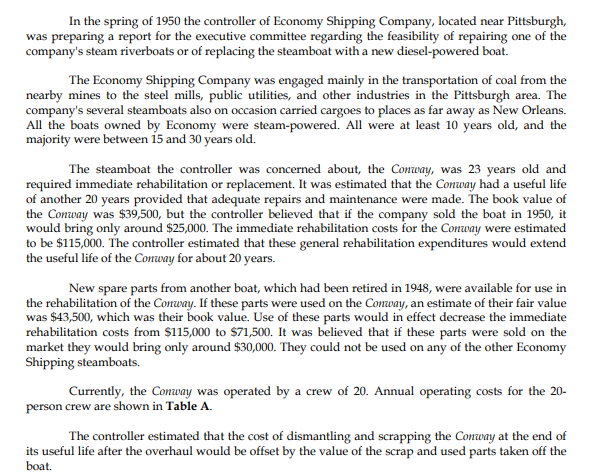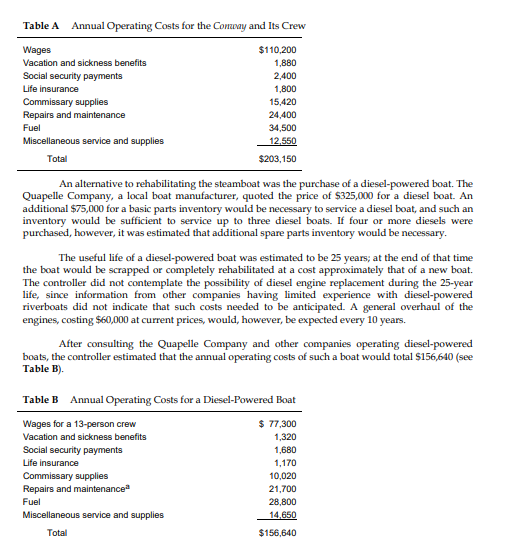Answered step by step
Verified Expert Solution
Question
1 Approved Answer
If possible please show how to evaluate the 2 boats in excel . In the spring of 1950 the controller of Economy Shipping Company, located




If possible please show how to evaluate the 2 boats in excel.
In the spring of 1950 the controller of Economy Shipping Company, located near Pittsburgh, was preparing a report for the executive committee regarding the feasibility of repairing one of the company's steam riverboats or of replacing the steamboat with a new diesel-powered boat. The Economy Shipping Company was engaged mainly in the transportation of coal from the nearby mines to the steel mills, public utilities, and other industries in the Pittsburgh area. The company's several steamboats also on occasion carried cargoes to places as far away as New Orleans. All the boats owned by Economy were steam-powered. All were at least 10 years old, and the majority were between 15 and 30 years old. The steamboat the controller was concerned about, the Conway, was 23 years old and required immediate rehabilitation or replacement. It was estimated that the Conway had a useful life of another 20 years provided that adequate repairs and maintenance were made. The book value of the Conway was $39,500, but the controller believed that if the company sold the boat in 1950 , it would bring only around $25,000. The immediate rehabilitation costs for the Conway were estimated to be $115,000. The controller estimated that these general rehabilitation expenditures would extend the useful life of the Conway for about 20 years. New spare parts from another boat, which had been retired in 1948, were available for use in the rehabilitation of the Conway. If these parts were used on the Conway, an estimate of their fair value was $43,500, which was their book value. Use of these parts would in effect decrease the immediate rehabilitation costs from $115,000 to $71,500. It was believed that if these parts were sold on the market they would bring only around $30,000. They could not be used on any of the other Economy Shipping steamboats. Currently, the Conway was operated by a crew of 20 . Annual operating costs for the 20person crew are shown in Table A. The controller estimated that the cost of dismantling and scrapping the Conway at the end of its useful life after the overhaul would be offset by the value of the scrap and used parts taken off the boat. Table A Annual Operating Costs for the Conway and Its Crew An alternative to rehabilitating the steamboat was the purchase of a diesel-powered boat. The Quapelle Company, a local boat manufacturer, quoted the price of $325,000 for a diesel boat. An additional $75,000 for a basic parts inventory would be necessary to service a diesel boat, and such an inventory would be sufficient to service up to three diesel boats. If four or more diesels were purchased, however, it was estimated that additional spare parts inventory would be necessary. The useful life of a diesel-powered boat was estimated to be 25 years; at the end of that time the boat would be scrapped or completely rehabilitated at a cost approximately that of a new boat. The controller did not contemplate the possibility of diesel engine replacement during the 25-year life, since information from other companies having limited experience with diesel-powered riverboats did not indicate that such costs needed to be anticipated. A general overhaul of the engines, costing $60,000 at current prices, would, however, be expected every 10 years. After consulting the Quapelle Company and other companies operating diesel-powered boats, the controller estimated that the annual operating costs of such a boat would total $156,640 (see Table B). Although the Economy Shipping controller had not considered the matter, at the end of the twentieth year the diesel boat would have a realizable value of $32,500 and the inventory of parts, $37,500. Another factor the controller was considering at this time was alternative uses of funds. In the spring of 1950, Economy had sufficient funds to buy four diesel-powered boats; however, there were alternative uses for these funds. The other projects the management was considering at this time had an estimated return of at least 10% after taxes. The income tax rate at the time was 48%. 1. Would you recommend the rehabilitation of the Conway or the purchase of the diesel-powered boat? To simplify the calculations, use the straight-line method of depreciation. Also, make the following assumptions: - The diesel boat, if acquired, would be sold at the end of the twentieth year; - The inventory of parts for the diesel can be depreciated for tax purposes over a 25-year period; - The hull of the diesel (\$265,000) would be depreciated over a 25-year period for tax purposes and the engines over a 10-year period; - The book cost of the Conway, including rehabilitation costs, would be depreciated over a 20 -year period if rehabilitation were chosen; - The $32,500 residual value for the diesel in year 20 assumes no overhaul of the engines in year 20Step by Step Solution
There are 3 Steps involved in it
Step: 1

Get Instant Access to Expert-Tailored Solutions
See step-by-step solutions with expert insights and AI powered tools for academic success
Step: 2

Step: 3

Ace Your Homework with AI
Get the answers you need in no time with our AI-driven, step-by-step assistance
Get Started


